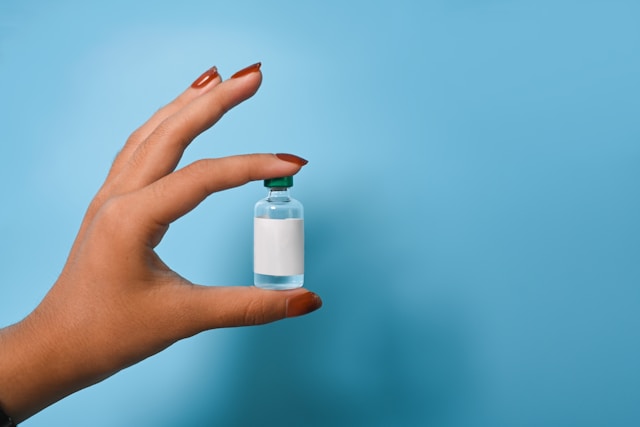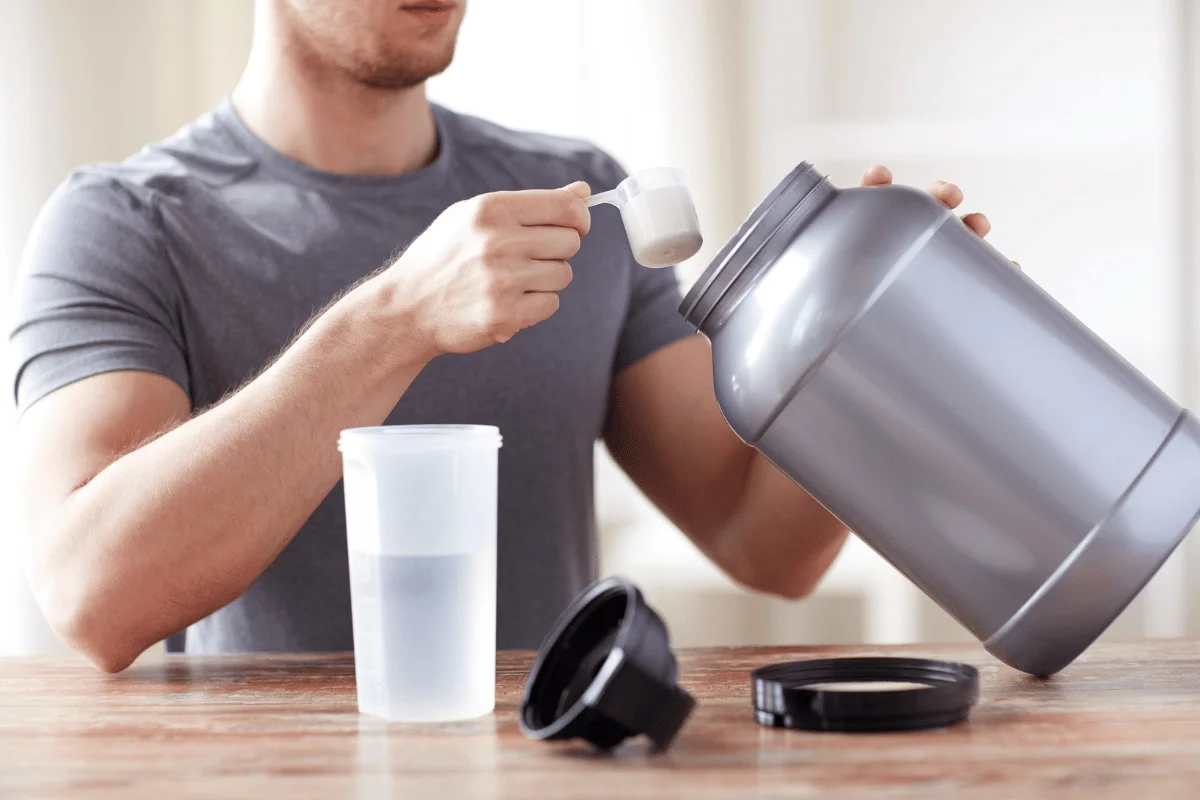[Disclaimer: This article is for informational purposes only and does not constitute medical advice. Always consult with a qualified healthcare provider before considering any peptide therapy.]
IGF-1 LR3 (Insulin-like Growth Factor 1 Long Arg3) is a synthetic analog of naturally occurring insulin-like growth factor-1, engineered to deliver more potent anabolic effects than regular IGF-1. This modified peptide has gained attention in bodybuilding and fitness circles for its reported ability to promote muscle growth and accelerate recovery.
The LR3 variant features structural modifications that extend its half-life to 20-30 hours, compared to natural IGF-1’s brief 12-15 minutes. This longer duration allows the peptide to remain active in your system, potentially amplifying its muscle-building effects.
Quick Takeaways
- IGF-1 LR3 is a synthetic peptide similar to insulin that may promote both muscle hypertrophy and hyperplasia through direct receptor activation.
- Starting doses range from 10-20 mcg daily, with cycles limited to 4-6 weeks to prevent receptor desensitization.
- Serious risks include hypoglycemia, potential cancer development, and organ growth at excessive doses.
- Natural alternatives like resistance training and proper nutrition can safely boost your IGF-1 levels without legal or health concerns.
What is IGF-1 LR3?
IGF-1 LR3 consists of 83 amino acids, compared to natural insulin-like growth factor’s 70 amino acid structure. The peptide gets its name from two key modifications: “Long” refers to 13 additional amino acids that increase stability, while “Arg3” indicates arginine replacing glutamic acid at position 3.
These changes reduce the peptide’s binding affinity to IGF-binding proteins (IGFBPs), which normally restrict natural IGF-1’s activity. Without this binding limitation, IGF-1 LR3 circulates more freely through your bloodstream.
The peptide is produced in the liver in response to growth hormone stimulation, though the synthetic LR3 version bypasses this natural pathway. Research shows that insulin-like growth factor-1 mediates many growth-promoting effects and has potent anabolic effects on skeletal muscle(1).
How IGF-1 LR3 Works in Your Body
IGF-1 LR3 works by binding directly to IGF-1 receptors on muscle cells, triggering intracellular signaling pathways including PI3K/Akt and mTOR cascades. This receptor activation sets off multiple anabolic processes throughout your muscles.
The peptide stimulates satellite cell proliferation and differentiation, which are critical for muscle repair and new muscle fiber formation. It also promotes protein synthesis while blocking protein breakdown, creating an anti-catabolic environment.
LR3 may improve glucose uptake and amino acid uptake into muscle tissue, leading to better nutrient partitioning. This means more of what you eat goes toward building lean muscle mass rather than fat storage.
Muscle Growth and Bodybuilding Benefits

The peptide’s primary appeal in bodybuilding and fitness lies in its dual mechanism. Unlike anabolic steroids that only increase the size of existing muscle fibers, IGF-1 LR3 may promote both hypertrophy and hyperplasia.
This creates what researchers describe as “true hypertrophy” through both enlarged muscle cells and new cell formation. The peptide activates satellite cells, which are muscle stem cells responsible for repairing and building new muscle tissue.
Building New Muscle Cells
IGF-1 LR3 triggers cell proliferation through direct muscle receptor binding. Studies indicate that insulin-like growth factor-1 induces proliferation and differentiation of muscle satellite cells, enabling hypertrophic adaptations in response to overload(1).
The peptide’s anabolic effects extend beyond simple cell division. It accelerates tissue regeneration and recovery through cellular repair mechanisms. This may reduce muscle soreness and enable more frequent training sessions.
Users report improved nutrient partitioning, with calories directed toward muscle growth rather than fat storage. The peptide also appears to preserve muscle mass during caloric restriction or post-cycle therapy.
Real World Muscle Gains
Bodybuilding sources report varied muscle gains based on experience level and cycle duration. Beginner cycles lasting 4-6 weeks may yield 3-5 pounds of lean muscle mass. Intermediate users running 6-8 week cycles report 5-10 pounds of muscle.
Advanced bodybuilders using multiple cycles over a year claim 10-15 pounds of permanent muscle gains. These figures come from anecdotal reports rather than controlled clinical trials in healthy individuals.
Performance benefits extend beyond size increases. Users note enhanced recovery between training sessions and improved strength metrics. Blood sugar levels may also improve through better insulin sensitivity and glucose uptake in muscle tissue.
Third-Party Tested, 99% Purity
Order lab-verified peptides from our top recommended vendor.

IGF-1 LR3 Dosage Guidelines
Proper dosing varies based on experience level, body composition goals, and individual response. Starting conservatively allows you to assess tolerance and minimize potential side effects.
The peptide’s long half-life means you don’t need multiple daily injections. Most protocols call for once-daily administration, though some experienced users inject every other day.
Starting Doses for Beginners
New users should begin at 10-20 mcg per day to evaluate tolerance. This conservative approach minimizes risks while allowing you to gauge your body’s response to the peptide.
Intermediate users typically increase to 20-40 mcg daily after establishing baseline tolerance. This range balances muscle-building potential with manageable side effect risk.
Advanced bodybuilders may use 50-100 mcg per day, though doses above 40 mcg increase the likelihood of adverse effects. Higher doses don’t necessarily produce proportionally better results due to receptor saturation.
| Experience Level | Daily Dose | Cycle Length |
|---|---|---|
| Beginner | 10-20 mcg | 4-6 weeks |
| Intermediate | 20-40 mcg | 4-6 weeks |
| Advanced | 50-100 mcg | 4-6 weeks |
Best Timing for Injections
Post-workout timing appears optimal for maximizing muscle growth. Injecting within 15-30 minutes after training may enhance nutrient uptake when your muscles are most receptive.
On non-training days, morning injections work well for maintaining consistent blood levels. Avoid injecting before bed due to hypoglycemia risk during sleep.
You can administer IGF-1 LR3 through subcutaneous or intramuscular injection. Subcutaneous is most common, while intramuscular injection may provide more localized effects in the injected muscle.
Cycling Protocols
Proper cycling prevents receptor desensitization and maintains the peptide’s effectiveness. Run cycles for 4-6 weeks maximum, then take equal time off before starting another cycle.
This on-off pattern allows your IGF-1 receptors to restore sensitivity. Running longer cycles may diminish returns as receptors become less responsive to stimulation.
Space your cycles with at least 4-6 weeks between each run. During off-time, focus on maintaining gains through consistent training and nutrition. Some users stack with other peptides for recovery during this period.
Potential Side Effects and Risks
Like any performance-enhancing compound, use IGF-1 LR3 carries both immediate and long-term health risks. Understanding these concerns helps you make informed decisions about whether the potential benefits justify the risks.
Medical supervision is absent for most users since the compound lacks FDA approval for human use. This means you’re experimenting without professional oversight or established safety protocols.
Common Side Effects
Hypoglycemia ranks as the most frequent and potentially dangerous immediate side effect. The peptide’s insulin-like effects can drop blood sugar levels dramatically, causing shakiness, confusion, and in severe cases, loss of consciousness.
Injection site irritation and redness occur commonly with peptide use. Muscle and joint pain may develop as your body adjusts to accelerated cell growth and tissue remodeling.
Other reported side effects include:
- Headaches and nausea
- Fatigue and weakness
- Water retention
- Temporary insulin resistance
Long-term concerns include desensitization of IGF-1 receptors with continuous use. This reduces the peptide’s effectiveness over time and may disrupt your body’s natural growth hormone production.
Serious Health Risks
Cancer risk represents the most troubling long-term concern. Large-scale research involving nearly 400,000 participants found that higher blood levels of IGF-1 increase risk for several types of cancer(2).
The study confirmed links between elevated levels of IGF-1 and increased risk of colorectal cancer, breast cancer, prostate cancer, and thyroid cancer. Dr. Anika Knüppel, lead investigator, noted: “IGF-1 helps to support normal cell growth and development; processes which can lead to cancer if they become dysregulated.”
Research also suggests that higher circulating levels of insulin-like growth factor-1 correlate with prostate cancer risk(3). The growth-promoting properties that build muscle may also stimulate cancer cell proliferation.
Organ growth at excessive doses poses another concern. Since IGF-1 receptors exist throughout your body, not just in muscles, the peptide affects all tissues. Prolonged high-dose use may cause unwanted growth in organs.
Medical professionals strongly advise against IGF-1 LR3 use if you have:
- Any history of cancer or tumors
- Severe illness of any kind
- Previous problems with GH therapy
- Multiple trauma history
- Severe breathing problems
The peptide’s legal status adds another layer of risk. IGF-1 LR3 is not FDA-approved for human use and is available only for research purposes. Professional sports organizations ban it as a performance-enhancing substance, and its use could have legal implications.
IGF-1 LR3 Compared to Alternatives
Several options exist for those seeking muscle growth and recovery enhancement. Understanding how IGF-1 LR3 compares helps you evaluate whether safer alternatives might meet your goals.
Each option carries distinct risk-benefit profiles. Natural methods take longer but avoid legal and health concerns, while other peptides may offer similar benefits with potentially better safety profiles.
IGF-1 LR3 vs Growth Hormone
Human growth hormone (HGH) and IGF-1 LR3 work through related but distinct pathways. HGH functions as a systemic hormone that triggers the liver to produce IGF-1, while LR3 provides direct effects on muscle tissue.
| Factor | IGF-1 LR3 | HGH |
|---|---|---|
| Half-life | 20-30 hours | 3-5 hours |
| Mechanism | Direct receptor binding | Liver → IGF-1 cascade |
| Primary Target | Skeletal muscle | Systemic effects |
| Legal Status | Research only | Prescription only |
| Bone Density | Limited effect | Improves density |
The longer half-life of IGF-1 LR3 means less frequent dosing compared to HGH’s multiple daily injections. IGF-1 LR3 targets muscle cells more directly, while growth hormone affects multiple body systems.
Both compounds carry serious risks and lack approval for performance enhancement. HGH requires a prescription for legitimate medical conditions, while LR3 remains available only for research applications.
Safer Peptide Options
Several alternative peptides may provide muscle-building and recovery benefits with potentially lower risk profiles. Growth hormone releasing peptides like Ipamorelin stimulate your body’s natural GH production rather than introducing synthetic growth factors.
Growth hormone secretagogues:
- Ipamorelin: Selective GH stimulator with minimal side effects and good tolerability
- GHRP-6: Potent GH release but may increase appetite significantly
- CJC-1295: Long-acting compound for sustained natural growth hormone release
Recovery-focused peptides:
- BPC-157: Promotes tissue healing without direct growth hormone effects
- TB-500: Anti-inflammatory properties support joint recovery and repair
- MGF (Mechano Growth Factor): Localized muscle repair and regeneration peptide
These alternatives work with your body’s natural hormone systems rather than bypassing them. Clinical trials data remains limited for most, but anecdotal evidence suggests better safety profiles than IGF-1 LR3.
Natural Ways to Boost IGF-1 Levels

You can increase your insulin-like growth factor 1 levels through lifestyle modifications that carry no legal risks or serious side effects. These approaches support long-term health while building muscle and improving body composition.
Natural methods may work slower than synthetic peptides but provide sustainable results. They also offer multiple health benefits beyond muscle growth, including improved metabolic health and longevity.
Exercise and Training
Resistance training stands out as the most powerful natural stimulus for IGF-1 production. Studies demonstrate that structured weight training programs significantly increase both muscle mass and IGF-1 concentrations(4).
High-intensity interval training can acutely elevate IGF-1 levels through metabolic stress and hormone signaling. Research indicates that regular physical exercise increases GH and insulin-like growth factor-1 activity, improving the aging process and quality of life(5).
Sprint exercises and explosive movements create acute spikes in growth factors. The combination of mechanical tension and metabolic stress triggers your body’s anabolic hormone response.
Effective training strategies include:
- Progressive overload with compound movements
- Training intensity above 70% of one-rep maximum
- Adequate rest between sessions for recovery
- Varied training splits targeting all muscle groups
Lifestyle Factors
Sleep quality directly impacts your natural growth hormone production and IGF-1 levels. Aim for 7-9 hours nightly, as GH secretion peaks during deep sleep stages.
Proper nutrition supports IGF-1 synthesis at the cellular level. Protein intake of 0.8-1.2g per pound of bodyweight provides amino acids needed for muscle building and hormone production.
Stress management plays a role since chronic stress suppresses natural growth factor production. Cortisol elevation from ongoing stress interferes with anabolic hormone signaling.
Managing metabolic syndrome through diet and exercise improves insulin sensitivity. Better glucose control supports healthy IGF levels and nutrient partitioning without synthetic intervention.
Final Thoughts
IGF-1 LR3 offers potent muscle-building effects through its direct action on muscle cells and extended half-life in circulation. The peptide may increase both the size of existing muscle fibers and create new muscle through satellite cell activation. Reported gains range from 3-10 pounds per cycle depending on experience level and dosing protocols.
The risks, though, warrant careful consideration. Cancer associations from large-scale studies, lack of FDA approval, legal restrictions, and immediate dangers like hypoglycemia create a concerning risk profile. Natural alternatives like resistance training combined with proper nutrition provide safer paths to muscle growth for most people.
For those still interested in peptide therapy, working with a medical professional and considering FDA-approved options may offer better risk-benefit ratios than experimental compounds like IGF-1 LR3.
References
- Stremming J, White A, Donthi A, Batt D, Hetrick B, Chang E, et al. Sheep recombinant IGF-1 promotes organ-specific growth in fetal sheep [Internet]. Vol. 13, Frontiers in Physiology. Frontiers Media SA; 2022 Aug. Available from: https://doi.org/10.3389/fphys.2022.954948
- Murphy N, Knuppel A, Papadimitriou N, Martin RM, Tsilidis KK, Smith-Byrne K, et al. Insulin-like growth factor-1, insulin-like growth factor-binding protein-3, and breast cancer risk: observational and Mendelian randomization analyses with ∼430 000 women [Internet]. Vol. 31, Annals of Oncology. Elsevier BV; 2020 May p. 641–649. Available from: https://doi.org/10.1016/j.annonc.2020.01.066
- Shanmugalingam T, Bosco C, Ridley AJ, Van Hemelrijck M. Is there a role for IGF‐1 in the development of second primary cancers? [Internet]. Vol. 5, Cancer Medicine. Wiley; 2016 Oct p. 3353–3367. Available from: https://doi.org/10.1002/cam4.871
- Cunha PM, Nunes JP, Tomeleri CM, Nascimento MA, Schoenfeld BJ, Antunes M, et al. Resistance Training Performed With Single and Multiple Sets Induces Similar Improvements in Muscular Strength, Muscle Mass, Muscle Quality, and IGF-1 in Older Women: A Randomized Controlled Trial [Internet]. Vol. 34, Journal of Strength and Conditioning Research. Ovid Technologies (Wolters Kluwer Health); 2020 Apr p. 1008–1016. Available from: https://doi.org/10.1519/jsc.0000000000002847
- Sundari LPR, Arsani NLKA. https://biomedpharmajournal.org/vol15no2/regular-physical-exercise-increase-of-growth-hormone-gh-and-insulin-like-growth-factor-1-igf-1-activity-in-elderly-improve-the-aging-process-and-quality-of-life-a-mini-review/ [Internet]. Vol. 15, Biomedical and Pharmacology Journal. Oriental Scientific Publishing Company; 2022 Jun p. 883–890. Available from: https://doi.org/10.13005/bpj/2422








